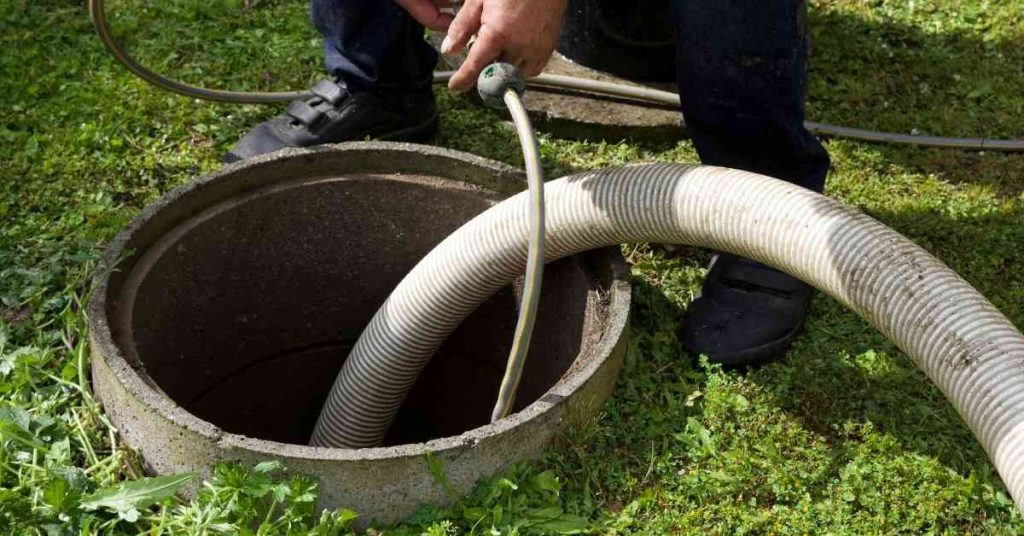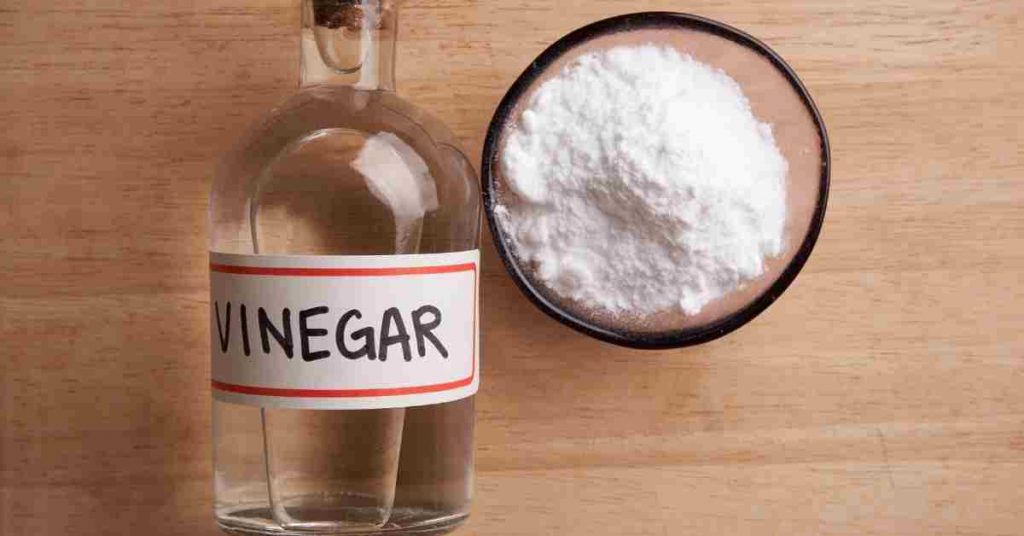Unclogging drains is a challenge for most people, but it can be an even bigger challenge when you are on a septic system. Why is that though?
Because a septic system depends on bacteria inside a septic tank to break down waste. Unclogging drains with anything toxic will disturb that balance resulting in expensive repairs.

If you are on a septic system and need to unclog a drain, try a combination of 1 cup baking soda, 1 cup vinegar and after 15 minutes blast boiling water through the drain. You can also plunge the drain, use a plumber’s snake and in the case of a sink remove and clean the P-trap.
Baking soda and vinegar are 100% septic-safe and quite effective in clearing drain clogs. While they can clear the clog perfectly on their own, adding boiling water in the mix helps to melt the clog even further and flush the drain line.
What about chemical drain cleaners like Drano? Are they septic-safe? Should you use Drano to unclog a drain when you are on a septic-system?
According to SC Johnson (Drano manufacturer), Drano is septic-safe and will not affect the bacterial activities in a septic tank. However, plumbers strongly advise against using Drano since not only is it unsafe for septic systems but it also damages drain pipes.
My recommendation is to always try to clear a clog naturally on your own and if you fail to do so to call a plumber. This is regardless of whether you are on a septic system or not.
Are Chemical Drain Cleaners Septic-Safe

Drano is not the only chemical drain cleaner out there. There are others like Liquid Plumr which are all advertised as “Septic-Safe”. But are they?
To really know if that is the case, you have to first understand how chemical drain cleaners work. Most chemical drain cleaners like Drano have sodium hydroxide as their active ingredient.
Sodium hydroxide is also known as lye or caustic soda. They also contain bleach, aluminum and other chemical salts. Some cleaners even contain acids like sulfuric acid.
To clear a clog, a series of chemical reactions takes place when you pour the cleaner down the drain line. The reactions are exothermic in nature, meaning they release heat to the surrounding.
It is this heat that melts clogs. If you are on a septic system, these chemicals will ultimately end up inside the septic tank. Lye works by decomposing organic matter.
The microbes inside the tank are organic in nature. So, what stops the lye from decomposing these bacteria? Nothing!
And that is where most people have a problem believing that these chemical drain cleaners are septic-safe. To be on the safe side I would advise you to steer clear from them.
Check out this post on exactly why plumbers hate Drano and would never recommend it.
Fortunately, there are other better and septic-safe ways to clear clogs from drains naturally.
Septic-Safe Methods to Unclog Drains
If you are looking for ways to unclog your drains that are septic-safe and that will not damage your pipes, these are some of the best:
1. Baking soda, Vinegar and Boiling Water Combination

Baking soda and vinegar are very effective in breaking down clogs. What is even important is that they are 100% septic-safe.
Baking soda is an alkali while vinegar is a weak acetic acid. When mixed together, the two create a fizzing reaction which is actually what breaks down the clog.
While baking soda and vinegar will clear a clog on their own, I like to incorporate boiling water as well. This combination will work on most clogs, unless you have a solid clog that cannot be broken down (like a rag inside a toilet drain line).
As a matter of fact, boiling water on its own will clear many drain clogs. The water melts grease in kitchen sink drains, breaks down tissue clogs in toilets drains and in shower/tub and bathroom sink drain break down hair balls which are responsible for most clogs.
This is how to unclog a drain using baking soda, vinegar and boiling water.
- Drain standing water. If the fixture you want to unclog has standing water, start by draining it. This allows the solution to work directly on the clog.
- Pour 1 cup of baking soda down the drain. If it is the toilet you are unclogging you can use slightly more since a toilet drain line is big. Alternatively, you can use just a cup of borax.
- Add another cup of vinegar slowly down the drain. Again, use more (2 cups of vinegar) when unclogging a toilet.
- Wait for 15 minutes for the reaction to take place and the solution to work out its magic.
- Meanwhile start boiling about a gallon or more of water.
- Dump the boiling water down the drain and check if the fixture drains out fast.
Note! Don’t use boiling water on a toilet lest you crack the bowl. Hot water from a faucet will work just fine.
As I have mentioned, baking soda and vinegar will break down the clog but the boiling water will melt the clog further and flush it down the drain.
2. Plunge the Drain

A plunger is a simple tool but it will clear most drain clogs in a few minutes. You however need to know how to use the plunger and also make sure you are using the right one.
To start with, it will depend on what you are unclogging. That is because there are 2 main types of plungers which work differently.
The first type of plunger is the flat-bottomed or cup plunger. This plunger is designed to unclog sink, shower and bathtubs drains.
The other type of plunger is the flange plunger which is bell-shaped. This plunger is specifically designed to unclog a toilet drain.
After choosing the right plunger, the next step is to apply a good technique when plunging. To start with, the fixture you want to unclog needs to have some water in it.
For toilet bowls, sinks and tubs it is usually recommended that they are at least ¼ full. The water helps the plunger seal properly at the bottom of the fixture.
If you are plunging a sink or bathtub, remember these fixtures have an overflow drain. You should seal the overflow before you start to plunge.
Failure to seal the overflow will mean that the pressure generated by the plunger will escape through the overflow which diminishes the effectiveness of the plunging. You can use an extra plunger to seal the overflow or stuff a rag/towel.
The next step is the actual plunging. Place the plunger around the drain opening and start plunging gently to engage the plunge and to also prevent water from splashing all over you.
After a few gentle plunges, start to plunge aggressively and continue doing it for 2 minutes without lifting off the plunger.
Finally lift the plunger and check if the water in the fixture will drain out on its own. If not, keep plunging.
3. Snake the Drain
A drain snake, also known as a plumber’s snake is a flexible cable with a cranking handle and a hooked head that either pulls out the clog or physically shreds it into tiny pieces.
Drain snakes aren’t particularly easy to use and not many people have them at home. However, if you would like to learn how to do it check out this post.
Instead of the traditional drain snake, there is another type of snake that you can use to clear clogs in bathroom fixtures (sinks, showers and bathtubs). In all of these drains, hair is responsible for most of the clogs.
The hair combines with soap scum, oils, shampoo and other bathroom products to form a sticky ball that clogs the drains and restrict it from draining.
A drain hair removal tool, also known as a zip-it tool is a plastic flexible snake with hooks on both sides that you simply insert in the drain and pull out the hair.

The tool is quite cheap but very effective. You also cannot damage your drains pipes with it since it is made from plastic.
In case you can’t get the tool and want to fix the problem immediately, a wire cloth hanger will come in handy. Just straighten the hanger, make a hook on one end and use it to fish out the hair from the drain.
Once finished, flush the drain with hot water.
4. Remove and Clean the P-trap
A P-trap is the U-shaped bend you see under your kitchen or bathroom sink. All the fixtures have one, only that you cannot see the one in your shower and bathtub drain.
The function of a P-trap is to hold water at all times therefore preventing sewer gases from coming up to the house, and also trap potential drain clogs preventing them from clogging the drain line farther away.

When you have a clogged or slow draining fixture, most of the time the clog is usually inside the P-trap. By removing and cleaning the P-trap you will have fixed the problem.
This is how to remove and clean a P-trap:
- Remove any items you have stored under the sink.
- Place a bucket or pan under the P-trap. Since the P-trap is full of water, you do not want it spilling on the floor.
- Disconnect the P-trap. Start with the shorter arm so that all the water can flow out via gravity. The connections are often hand-tight and you should only use a wrench when bare hands can’t loosen it.
- After removing the P-trap, inspect and clean it with hot soapy water. Also clean the pipe leading away into the wall as well as the tail piece connected to the sink drain opening.
- Connect the P-trap back and turn on the hot water faucet to flush the drain line and to also confirm that the trap is not leaking.
And basically that is how to unclog drains when you are also on a septic system. When these methods don’t work, you are better off calling a plumber instead of resulting to a chemical drain cleaner.





